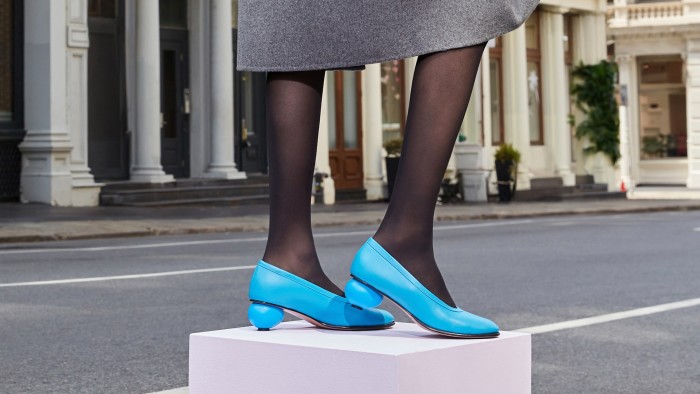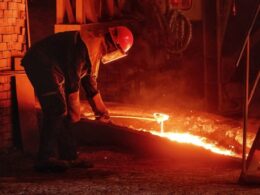This article is part of FT Globetrotter’s guide to New York
The creators of Sex and the City and its sequels are likely responsible for millions of pinched toes, blisters, and aching foot arches. For almost three decades, women have watched its protagonists strut down New York avenues in barely-there slip-on stilettos, inspiring many of them — not least me — to attempt such feats of stamina and athleticism ourselves. Shoes, we were told, were the means to a fabulous life.
But New York’s love affair with shoes isn’t just a pop culture fantasy — it’s built on something real and enduring. In the 1980s, the city was a centre of the sneaker culture boom, fuelled by the rise of hip hop and basketball. Before that, department stores such as Henri Bendel, Lord & Taylor and Barneys lined Fifth Avenue, making New York a shoe destination for women from around the world. From the mid-19th century, it was a shoe-manufacturing hub (according to a 1921 report, only 5.6mn people lived in New York, but the city produced over 20mn pairs of shoes — more than any other region in the country). Even today, you see traces of that past: New York still boasts a remarkably high number of cobblers, little old shops run by footwear wizards who can breathe new life into almost any shoe, giving your favourite pairs a few more years (if not decades).

Things have changed, of course. Shoe manufacturing left with other urban manufacturing. With the rise of the internet, department stores changed shape and dwindled, too. But sometimes you don’t want to click through pages of shoes, buy six pairs, hope one fits and lug the rest back to the post office. Sometimes you just need a shoe store. After a lifetime chasing footwear, I’ve concluded that in-person shopping is still the best way to buy women’s shoes, and New York is still the best place to do it.
Here are three places to find your footing in New York’s ever-evolving shoe scene. Whether you want a closet full of options or a select few classics; unique pieces nobody else has or the latest trend; shoes for an event or just the chance to browse and dream — there’s a strategy to suit your style.
Option one: the good old fashioned department store
On a spring weekday afternoon, I wandered through the historic department store Bergdorf Goodman to peruse the shoes on its second floor. There weren’t many customers, but there were a lot of shoes. I tried and failed to count them. I got to 200 and then began to hallucinate.
“Shoes are a drug,” a shoe salesman in the Manolo Blahnik section told me, “and I’m their drug dealer. Coming here is like hunting, and I’m the one who knows where the treasure is.”
Here are the tricks of the trade of this salesman (who wasn’t authorised to do an interview, so asked not to be named): he starts by assessing the customer’s foot, style and personality (“I could look at your foot and tell you what’s going to fit”). This can happen without you even noticing, in a split second, as you step off the escalator.
If you are looking for a specific style (for me it was a pair of Gianvito Rossi block-heel Mary Janes in black patent leather), he’s running through five comparable ones you might not have spotted.


As a veteran shoe-buyer, I doubted he could show me anything I didn’t already know. But without missing a beat, he picked up a pair of black patent Mary Janes (box ticked), but from Celine, with a slightly taller heel (still in my acceptable range) and a subtle logo on the toe.
“I’m showing you something you never would have looked at,” he said. And he was right.
I recommend you let the salespeople work their magic; they know their trade, and some approach it in almost academic terms (mine told me he once penned an essay about how the pandemic changed the structure of people’s feet). At the end of the day, they are on your side, not the shop’s, because “if a shoe is returned, we have to give the commission back”.

While Bergdorf Goodman is the city’s oldest high-end luxury department store (when it opened, women still wore corsets), Printemps is its newest and most glamorous. The French chain’s first US location is at One Wall Street, a grand, art deco skyscraper with a mosaic and marble lobby. Printemps’ shoe salon is an actual designated interior landmark — it’s called The Red Room, and entering it is like finding yourself in a 1930s Alice in Wonderland set that’s brimming with shoes. The selection here seems to be targeting a younger consumer than at Bergdorf or Saks, with younger designers and more flats and sneakers on display.
After an hour of snooping, I’d estimate that to take a pair of shoes home at Bergdorf or Printemps you’d have to part with at least $750 on average — and it’s not uncommon for ladies who shop there to drop a few thousand dollars in an afternoon. When I want to find similar shoes with a less painful price tag, I usually turn to TheRealReal, a luxury consignment shop. TheRealReal has a handful of stores scattered around New York City, but the real hunt is online. Here’s how to win: create saved searches in its app, which are narrowly curated by brand, size and style. This may require some trial and error initially, but then it runs like a smoothly oiled machine, delivering you your desired shoes for a fraction of the price. One of my favourites is the Ferragamo Vara pumps, which cost $880 new and are plentiful on TheRealReal for under $250.
Option two: think outside the brand box with an independent boutique
A department store will always be impersonal, no matter how attentive the salespeople. If you want the opposite experience, I recommend independent boutiques like Gray Matters, founded by Silvia Avanzi in 2016.
Avanzi is more than happy to help you pick out a shoe herself, and glows when someone shows appreciation for her creations: low- and mid-heeled designs made of supple calf leather in whimsical, sculptural shapes. They are currently between physical stores, but in her recent SoHo location there were shoes with heels shaped like eggs (I bought them), daringly oversized buckles (I want them) and asymmetric cutaways.


“A lot of our customers are architects or artists, or lawyers with an art collection, for example,” she told me on a recent visit. “Somebody who appreciates, understands and buys into these aesthetics.”
The idea behind the brand is straightforward: aesthetically sophisticated shoes that are also practical for a big city like New York. “I wanted to make a low heel that was cool, dynamic, and interesting,” Avanzi said, not old-fashioned, like the shoes your grandmother might have worn in the 1950s. She drew inspiration from the low-heeled ankle boot popularised by Isabel Marant in the mid-2010s, but slimmed down the silhouette, transforming the boot into more of a pump. (The resulting shoe is still part of the collection, and to my eyes, isn’t dated at all — a rare achievement in the world of ever-evolving fashion aesthetics.)


Avanzi’s designs are priced around $500, but the quality is on par with the $1,000 pairs at Bergdorf. The shoes are made in Italy, the leather is supple and I didn’t get any blisters after a full day of walking on my new egg-shaped heels. “We really compete against designer brands, offering a very similar product at a lower price. We wanted to be accessible to a young woman who, let’s say, is on her first job.”
Despite being in business for almost a decade, Gray Matters still faces scepticism. Avanzi says some people think, “If the product is good, why haven’t I seen it around more?” This is a common challenge for independent brands, but for me, the scarcity is exactly the point. You’ll find the same Gucci loafer on the streets of Doha, London or New York. But only the cognoscenti will know the Gray Matters Egg Pump.
Gray Matters works with shapes. If colour is more your thing, take a look at New York brand Mansur Gavriel. It specialises in more classic styles, like a ballet flat or a minimal sandal, but always in a wide array of vibrant colours. One season the palette might be pastel lavenders, baby blues and butter yellows, the next it will be saturated primary colours à la Mondrian. The only risk here is falling in love with colours that don’t work well with your style. If this occurs, they also make beautiful handbags with the same leather.
-
Gray Matters: The shop is between locations. Their SoHo address just closed, and they are online only until they find another retail space. Instagram; Website
-
Mansur Gavriel: Stocked at Saks Fifth Avenue, Bloomingdale’s and other outlets. Website
Option three: invest in timeless shoes
Big-name designers launch multiple collections a year. To create demand, they find ways to imply that last season’s hot shoe is now a dud. Trends are in constant flux. But there is another way.
Buy a classic style: the lace-up Oxford, the penny or tassel loafer, the Chelsea boot. These have now served both men and women for more than a century, and have never, as far as I’m concerned, gone out of fashion.


For the timeless shoe, the independent boutique Leffot on Christopher Street in the West Village is your spot. Leffot offers most classic models from brands at three price-points: entry, mid and high-end. A pair of tassel loafers will cost anywhere between $500 for a calfskin model and $2,500 for a type of horse leather called cordovan, made from the connective tissues on the animal’s rump (this makes it smoother and more durable than other leathers). The store’s owner Steven Taffel is picky about what he sells. “I like to work with brands that actually make their own shoes,” he says, a key difference to many conglomerate-owned designer brands that produce their shoes in factories they do not control.

Nominally, Leffot is a men’s shoe store. But Taffel’s relationships with shoemakers mean he can create custom designs, and order them in sizes for women, too (if you are a European size 39 or larger, you may already fall within the men’s size range).
If you like the idea of a classic loafer or Oxford but prefer it in a more feminine form, turn to shoemakers such as Spanish brand Carmina or the UK’s Crockett & Jones, both near Madison Avenue and 53rd Street. The women’s versions are often built slightly differently: the welt is thinner and the last is narrower, creating a more elegant profile. If you want to go further, consider the heeled versions. They give you the height and posture of a classic pump, but are sturdier and more weather-resilient. Whichever shoe you choose, maintain it well with proper polish and regular visits to those cobbler wizards. Your new pair can serve you for decades, if not a lifetime.
Share your New York shoe-shopping tips in the comments below. And follow FT Globetrotter on Instagram at @FTGlobetrotter
Cities with the FT

FT Globetrotter, our insider guides to some of the world’s greatest cities, offers expert advice on eating and drinking, exercise, art and culture — and much more
Find us in New York, Paris, Rome, London, Tokyo, Lagos, Frankfurt, Singapore, Hong Kong, Miami, Toronto, Madrid, Melbourne, Copenhagen, Zürich, Milan, Vancouver, Edinburgh and Venice









